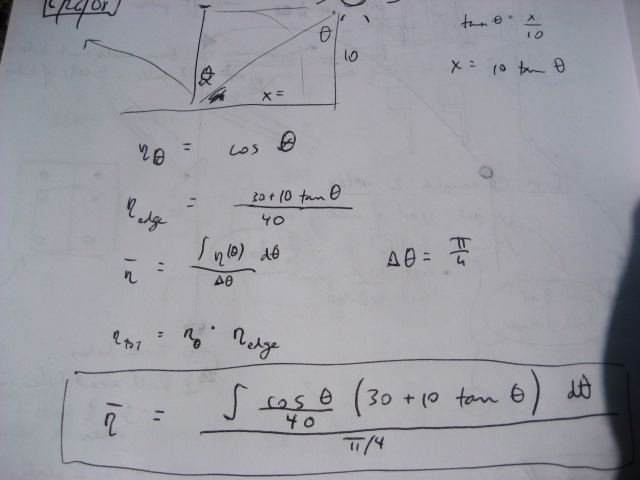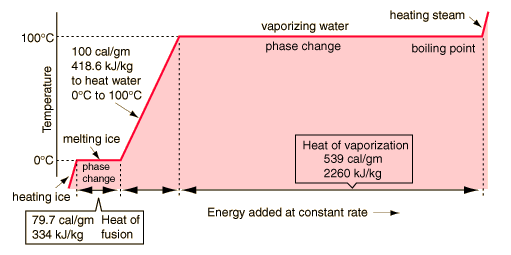Solar Collector Calculations
Losses due to edge effects and lack of daily tracking
If we use a passive tracking arrangement for the collector, with only seasonal adjustment, then we have two losses:
- Loss due to the sun not being perpendicular to the array - if theta is the angle measured from the position of the sun at high noon - then the efficiency stemming from this varies as cosine(theta)
- Loss due to edge effects - when the sun is not directly overhead, part of the collector tube is not illuminated (assuming length of collector tube is the same as the length of the reflectors)
The overall average efficiency (eta bar) considering these two losses - for the 6 hours of the day around high noon - is:
This value - I estimate to be around 75% - for the average efficiency of the collector without daily tracking.
Someone please run this on the computer or analytically and fill in the exact value.
Losses due to edge effects only
For a 40x10 foot solar collector array, with length running East to West, this is a table of losses corresponding to the edge efficiencies (Greek eta_edge) represented by the
term in the above equations:
Vapor Generation Rate
Based on water, we have:
generating steam
the energy needed to heat a mass of water is given by:
E = M * Specific heat * change in temp
The Energy needed to vaporize a mass of water is given by:
E = M * heat of vaporization
The energy needed to raise the temperature of the water and then vaporize it is the sum of the two. Because we are dealing with power instead of energy, we can replace mass by the mass flow (g/S).
Power = Massflow * (Specific heat * change in temp + Heat of vap)
or
Massflow = P / (Specific heat * change in temp + Heat of vap)
for our specific case:
Power = 20,000 J/s (20 Kw)
Change in temp = 300 C (from room temperature to 330 C)
specific heat= 4J/g
heat of vaporization=2,226 J/g
Mass Flow= 5.64 g/s or 44 lb/Hour
Generating Steam at 180C/350F
Specific heat of water: 1 Cal/g/C = 1 kCal/kg/C = 4 kJ/kg/C
Heat of Vaporization: 2270 kJ/kg
Specific heat of steam: 1/2 Cal/g/C = 2 kJ/kg/C
To raise water from 20C to 180C, which would be a good working pressure of 10 atmospheres or 140 psi [1]
Heating of water from 20 to 100C - 320 kJ/kg Vaporization - 2270 kJ/kg Raising steam temperature from 100 to 180C - 160 kJ/kg
Total - 2750 kJ/kg
We have 20 kW available, or 72,000 kJ/hr -
(72,000 kJ/hr)/(2750 kJ/kg) = 26 kg/hour
Steam generation rate is 26 kg/hour, or 58 lb/hr



